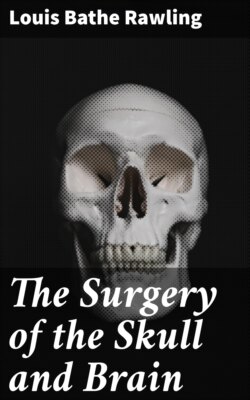Читать книгу The Surgery of the Skull and Brain - Louis Bathe Rawling - Страница 52
На сайте Литреса книга снята с продажи.
Operation.
ОглавлениеThe unhealthy condition of the overlying integument, especially at the apex of the tumour, prohibits any extensive preparatory cleansing, this process being carried out for the most part when the child is under the anæsthetic.
Scalp-flaps are framed from the region of the base of the tumour, advantage being taken of the more healthy parts. These flaps must be so sized and framed that accurate approximation and complete covering to the gap will be attained at the termination of the operation. The flaps are dissected back to their base. The pedicle of the tumour is defined and an endeavour made to detach it completely from the margins of the osseous defect. This is often a matter requiring considerable patience. The sac of the tumour should then be tapped with trocar and cannula, and the fluid contents allowed to escape slowly, after which the opening into the sac is enlarged and the membranes slit up towards the base of the protrusion.
When dealing with a pure meningocele, the membranous protrusion is cut away in such a manner that sufficient tissue is left to allow of closure of the dural gap. This closure can be carried out either by means of a purse-string suture or by the union of two lateral flaps. In either case, accurate approximation is essential in order to prevent as far as possible the further escape of cerebro-spinal fluid.
If the sac should contain an irregular mass of neuroblastic and mesoblastic tissue, apparently not true cerebral or cerebellar substance, this material can be dissected from the membranous sac, ligatured at its base, and freely cut away.
If the sac should contain true brain substance, the possibility of excision can be raised. In the cerebellar region such measures are contra-indicated, and the surgeon must remain content with an attempt at replacing the cerebellar substance within the cranial cavity. This attempt at reposition will be aided by elevation of the head and, occasionally, by lumbar puncture. If the protrusion corresponds to a region which has no known important function, it may be ligatured and cut away flush with the surface of the gap. Hæmorrhage may be considerable, but can be controlled by ligature, pressure, and irrigation with hot water at a temperature between 110 and 115 degrees Fahrenheit. The degree of shock attendant on the operation may be severe, necessitating the most complete attention to preliminary, operative, and post-operative details (see Chap. I).
To remedy the defect of the bone Lyssenkow recommends an osteoplastic operation, a flap composed of pericranium, together with the external table of the skull, being framed from the bone above the defect.
The flap is then turned down in such a way that the pericranial surface faces towards the dura, and the fragment is suspended by the continuity of the pericranium. He reports 72 cases so treated, with 37 recoveries and 35 deaths.
König and von Bergmann oppose this osteoplastic operation on the ground that the extreme thinness of the bone seldom permits of the necessary splitting off of the external table of the skull, and that, even when such a course is feasible, the fragment undergoes necrosis.
Transplantation of decalcified and calcined bone, silver and celluloid plates, have all been tried, with no great amount of success. Ssamoylenko proposes paraffin and vaseline injections, especially for the sincipital variety of cephalocele.
When the surrounding bone is of such a nature that it is possible to form an osteoplastic flap, that course should be adopted. Under other circumstances, it would appear preferable to postpone any attempt to close in or protect the gap in the bone in the hope that nature will remedy the defect in part, the surgeon stepping in at a later date with one of the measures advocated for the protection of gaps in the skull (see p. 196).
